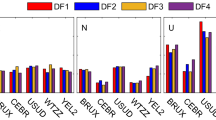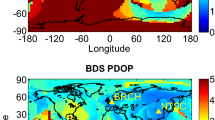Abstract
Estimates of satellite clock offsets typically employ dual-frequency undifferenced (UD) ionospheric-free (IF) observations from global network. The third-generation BeiDou Navigation Satellite System (BDS-3) can transmit B1I (1561.098 MHz), B3I (1268.52 MHz), B1C (1575.42 MHz), B2a (1176.45 MHz), B2b (1207.14 MHz) and B2ab (1191.795 MHz) signals. To make full use of the advantage of BDS-3 multi-frequency signals and improve BDS-3 service performance, we present some new quad-frequency satellite clock estimation techniques using B1I/B3I/B1C/B2a signals, which are QFIF0 model combining B1I/B3I and B1C/B2a IF observables, QFIF1 model combining the B1I/B3I, B3I/B1C and B1I/B2a IF observables, QFIF2 model combining B1I/B3I and B1I/B3I/B1C/B2a IF observables, and quad-frequency uncombined QFUC model, respectively. These new techniques only improve the performance of satellite clock estimation by fully utilizing the BDS-3 multi-frequency observations on the premise of ensuring the dual-frequency IF datum but also obtain the corresponding inter-frequency clock bias (IFCB) simultaneously. The quad-frequency satellite clock offsets are evaluated in terms of the clock offset precision, the modified Allan deviation (MDEV) and precise point positioning (PPP) performances. The new methods can improve the performances of the estimated clock offsets compared with the traditional dual-frequency IF model. The precision for the estimated clock offsets using quad-frequency satellite clock estimation models can be improved by 13–26% in terms of standard deviation (STD). The improvement of frequency stability ranges from 0 to 24%, especially for the short-term stability, which can reach 12% and 24% for B1I/B3I and B1C/B2a clock offsets, respectively. Similarly, the corresponding PPP performance has also been better improved with respect to those of using traditional dual-frequency IF clock offsets. Thus, the proposed quad-frequency satellite clock estimation techniques can be well applied into precise satellite clock estimation.















Similar content being viewed by others
Data availability
The datasets analyzed during this study are available in the IGS MGEX repository (ftp://cddis.gsfc.nasa.gov/pub). The BDS-3 precise orbit and clock products are available in the GFZ (ftp://ftp.gfz-potsdam.de/GNSS/products).
References
Defraigne P, Bruyninx C (2007) On the link between GPS pseudorange noise and day-boundary discontinuities in geodetic time transfer solutions. GPS Solut 11(4):239–249. https://doi.org/10.1007/s10291-007-0054-z
Ge Y, Cao X, Shen F, Yang X, Wang S (2021) BDS-3/Galileo time and frequency transfer with quad-frequency precise point positioning. Remote Sens. https://doi.org/10.3390/rs13142704
Geng J, Wen Q, Zhang Q, Li G, Zhang K (2022) GNSS observable-specific phase biases for all-frequency PPP ambiguity resolution. J Geodesy. https://doi.org/10.1007/s00190-022-01602-3
Guo J, Geng J (2017) GPS satellite clock determination in case of inter-frequency clock biases for triple-frequency precise point positioning. J Geodesy 92(10):1133–1142. https://doi.org/10.1007/s00190-017-1106-y
Hopfield HS (1969) Two-quartic tropospheric refractivity profile for correcting satellite data. J Geophys Res 74(18):4487–4499. https://doi.org/10.1029/JC074i018p04487
Jiao G, Song S, Su K, Liu Y (2022) Improving BDS-2 and BDS-3 integrated satellite clock determination with inter-system bias estimation for precise point positioning. In: China satellite navigation conference (CSNC 2022) proceedings: https://doi.org/10.1007/978-981-19-2576-4_11
Kouba J (2009) A guide to using international GNSS service (IGS) products.
Kuang K, Zhang S, Li J (2019) Assessment of L5 frequency on real-time GPS orbit and clock estimation. Adv Space Res 64(11):2189–2198. https://doi.org/10.1016/j.asr.2019.07.026
Kuang K, Wang J, Han H (2022) Real-Time BDS-3 clock estimation with a multi-frequency uncombined model including new B1C/B2a signals. Remote Sensing. https://doi.org/10.3390/rs14040966
Landskron D, Bohm J (2018) VMF3/GPT3: refined discrete and empirical troposphere map** functions. J Geod 92(4):349–360. https://doi.org/10.1007/s00190-017-1066-2
Li H, Li B, **ao G, Wang J, Xu T (2015) Improved method for estimating the inter-frequency satellite clock bias of triple-frequency GPS. GPS Solut 20(4):751–760. https://doi.org/10.1007/s10291-015-0486-9
Montenbruck O, Hugentobler U, Dach R, Steigenberger P, Hauschild A (2011) Apparent clock variations of the Block IIF-1 (SVN62) GPS satellite. GPS Solut 16(3):303–313. https://doi.org/10.1007/s10291-011-0232-x
Montenbruck O, Hauschild A, Steigenberger P (2014) Differential code bias estimation using multi-GNSS observations and global ionosphere maps. In: Proceedings of the 2014 international technical meeting of the Institute of Navigation, 802–812.
Pan L, Zhang X, Guo F, Liu J (2018) GPS inter-frequency clock bias estimation for both uncombined and ionospheric-free combined triple-frequency precise point positioning. J Geodesy 93(4):473–487. https://doi.org/10.1007/s00190-018-1176-5
Petit G, Luzum B (2010) IERS conventions (2010). No. IERS-TN-36. Bureau International des Poids et Mesures Sevres (France)
Rebischung P, Schmid R (2016) IGS14/igs14.atx: a new framework for the IGS products In: AGU fall meeting 2016. San Francisco, CA; 2016. pp 6109–6131
Schaer S, Villiger A, Arnold D, Dach R, Prange L, Jäggi A (2021) The CODE ambiguity-fixed clock and phase bias analysis products: generation, properties, and performance. J Geodesy. https://doi.org/10.1007/s00190-021-01521-9
Su K, ** S (2021) Analytical performance and validations of the Galileo five-frequency precise point positioning models. Measurement. https://doi.org/10.1016/j.measurement.2020.108890
Su K, ** S, Jiao G (2022) GNSS carrier phase time-variant observable-specific signal bias (OSB) handling: an absolute bias perspective in multi-frequency PPP. GPS Solut. https://doi.org/10.1007/s10291-022-01255-x
Villiger A, Dach, R (2022) International GNSS Service Technical Report 2021 (IGS Annual Report). IGS Central Bureau and University of Bern. https://doi.org/10.48350/16953
Wang N, Yuan Y, Li Z, Montenbruck O, Tan B (2015) Determination of differential code biases with multi-GNSS observations. J Geodesy 90(3):209–228. https://doi.org/10.1007/s00190-015-0867-4
Wang K, Khodabandeh A, Teunissen PJG (2018) Five-frequency Galileo long-baseline ambiguity resolution with multipath mitigation. GPS Solut. https://doi.org/10.1007/s10291-018-0738-6
Wang C, Zhao Q, Guo J, Liu J, Chen G (2019) The contribution of intersatellite links to BDS-3 orbit determination: model refinement and comparisons. Navigation 66(1):71–82. https://doi.org/10.1002/navi.295
Xu G, Xu Y (2016) GPS: theory, algorithms and applications, 3rd edn. Springer, Berlin
Yang Y, Xu Y, Li J, Yang C (2018) Progress and performance evaluation of BeiDou global navigation satellite system: data analysis based on BDS-3 demonstration system. Sci China Earth Sci 61(5):614–624. https://doi.org/10.1007/s11430-017-9186-9
Yang Y, Liu L, Li J, Yang Y, Zhang T, Mao Y, Sun B, Ren X (2021) Featured services and performance of BDS-3. Sci Bull 66(20):2135–2143. https://doi.org/10.1016/j.scib.2021.06.013
Yao Y, He Y, Yi W, Song W, Cao C, Chen M (2017) Method for evaluating real-time GNSS satellite clock offset products. GPS Solut 21(4):1417–1425. https://doi.org/10.1007/s10291-017-0619-4
Ye S, Zhao L, Song J, Chen D, Jiang W (2017) Analysis of estimated satellite clock biases and their effects on precise point positioning. GPS Solut. https://doi.org/10.1007/s10291-017-0680-z
Zaminpardaz S, Teunissen PJG, Khodabandeh A (2021) GLONASS–only FDMA+CDMA RTK: performance and outlook. GPS Solut. https://doi.org/10.1007/s10291-021-01132-z
Zhou W, Cai H, Chen G, Jiao W, He Q, Yang Y (2022) Multi-GNSS combined orbit and clock solutions at iGMAS. Sensors. https://doi.org/10.3390/s22020457
Zumberge JF, Heflin MB, Jefferson DC, Watkins MM, Webb FH (1997) Precise point positioning for the efficient and robust analysis of GPS data from large networks. Journal of Geophysical Research: Solid Earth 102(B3):5005–5017. https://doi.org/10.1029/96jb03860
Acknowledgements
This research is supported by the National Natural Science Foundation of China (No.12073063).
Author information
Authors and Affiliations
Corresponding author
Additional information
Publisher's Note
Springer Nature remains neutral with regard to jurisdictional claims in published maps and institutional affiliations.
Rights and permissions
Springer Nature or its licensor (e.g. a society or other partner) holds exclusive rights to this article under a publishing agreement with the author(s) or other rightsholder(s); author self-archiving of the accepted manuscript version of this article is solely governed by the terms of such publishing agreement and applicable law.
About this article
Cite this article
Jiao, G., Song, S. & Su, K. Improving undifferenced precise satellite clock estimation with BDS-3 quad-frequency B1I/B3I/B1C/B2a observations for precise point positioning. GPS Solut 27, 28 (2023). https://doi.org/10.1007/s10291-022-01364-7
Received:
Accepted:
Published:
DOI: https://doi.org/10.1007/s10291-022-01364-7




